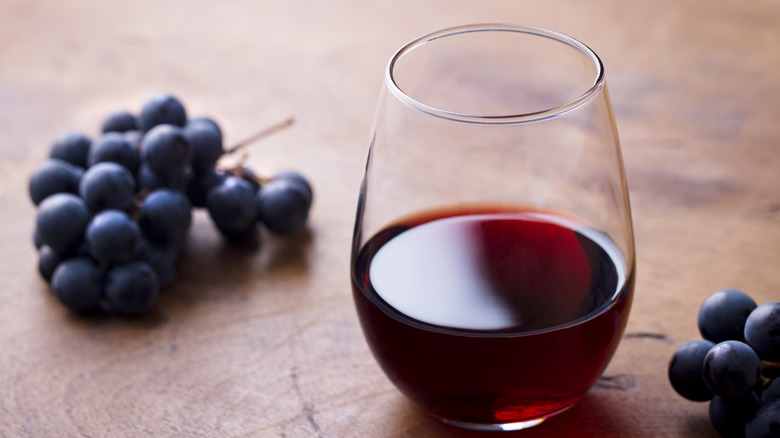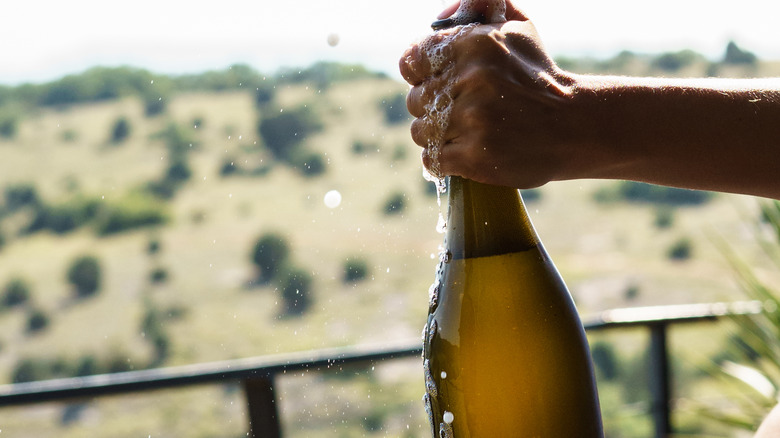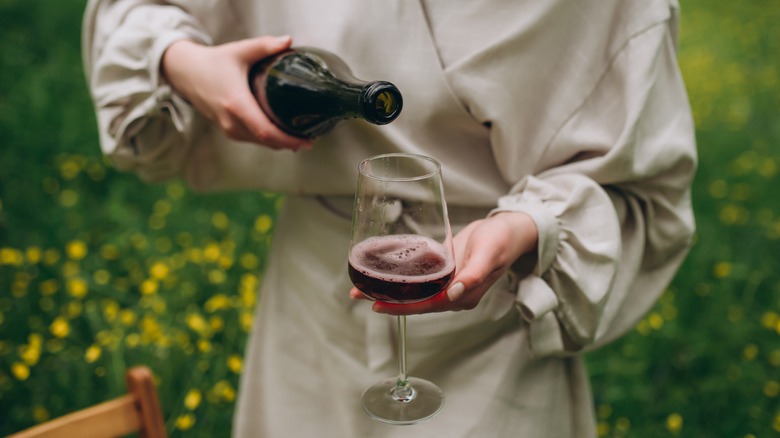Glou-Glou: The 1600s Wine Term That Morphed Into A Trend
In a world of endless wine terms, "glou-glou" has to be our favorite — and can you blame us? Translating to the English equivalent of "gulp-gulp" or "glug-glug", this style of wine is quite literally named after the sound of grape juice rapidly pouring out of a bottle and the quick guzzling that follows. Unsurprising nomenclature that's reserved for easy-to-drink vino, glou-glou wines might currently be served in all the "it" wine bars and restaurants across the globe, but you might be surprised to learn that the term isn't new.
In fact, despite the renaissance of glou-glou, the term (and corresponding wine style) have fairly antiquated origins. Yet, while the phrase has often described a genre of wines that aren't overly uncomplicated, measured instead by the level of pleasure and refreshment they provide, the true significance of glou-glou has been drastically shaped by time and travel. Trendy as it may seem, the evolution of glou-glou can teach us a lot about history and our long-standing, collective desire to drink good wine with good food and even better company.
To glou is to gulp
Like most effortlessly chic food and wine concepts, it isn't surprising that the first inklings of the term glou-glou can be traced back to France. While an exact date is hard to pinpoint in oral history, Sprudge Wine states the first mentions of glou-glou in literature appeared in playwright Molière's 1666 satire titled "The Doctor Despite Himself" before later reappearing in the works of writers like Alexandre Dumas and Emile Zola. However, the term was meant to mean "drink" or potentially even "gulp" or "guzzle," depending on the number of times it was used in sequence.
As for when glou-glou gained meaning within the wine community, the phrase is believed to have emerged from regions like Beaujolais. According to Juiced Wines, it wasn't the actual winemakers who began using the phrase, but rather the harvest workers that started referring to the fresh fruits of their labor as extremely drinkable. With the easy potential to be chugged and glugged, these thirst-quenching wines became known as glou-glou. However, glou-glou didn't become part of the vigneron's (or consumer's) vernacular until movements campaigning natural wine sent the term soaring to new heights.
Glou-glou for the modern times
Beginning with Jules Chavet, who started the revolution towards minimalist winemaking, a Beaujolais-based group known as the Gang of Four — Marcel Lapierre, Jean Foillard, Jean-Paul Thévenet, and Guy Breton — further cemented this idea in the 1970s. With a focus on producing low-intervention wines, MYSA shares that glou-glou was typically used by importers such as Dressner to describe many of the charming yet, easy-to-consume reds like that of Lapierre.
Much like a fresh vin de soif that's often low in alcohol and tannin, glou-glou quickly came to represent an unpretentious style of red wine that was fresh, juicy, and fruity. Still an excellent display of terroir, these vibrant wines eventually piqued the attention of importers and figures in the wine world, allowing the French phrase of glou-glou to venture into foreign lands and become part of a bigger oenological dialogue.
As for what glou-glou signifies today, the term encompasses a wider selection of wines beyond juicy reds from France. Moreover, glou-glou has become part of a revolution making wine more accessible and inviting to everyone as the whimsical style challenges traditional wine culture. But don't mistake these wines as blatantly simplistic or to be consumed without thought. The reality is that while glou-glou wines are designed for easy consumption, they still have much to offer beyond their unique ability to quench thirst and complement any scenario. Intrigued?
How to identify glou-glou wines
Glou-glou wine can be identified with labels, such as a bottle from Las Jaras Wines or other smaller brands. Varying from red to white, rosé, and even orange, these vins de soif can also be produced anywhere in the world. However, certain elements can help you distinguish a crushable bottle from the rest.
Nestled under the umbrella of natural wine, glou-glou wines will likely be found at retailers specializing in low-intervention wines. Visually, glou-glou wines often boast playful and artsy labels that provide a sneak peek into what the wonderfully colored wines inside may offer. Occasionally cloudy and sometimes with bits of sediments, these wines may even be closed with a crown cap rather than a cork in the case of delicately effervescent wines such as pét-nat.
Suitable for any and every palate, glou-glou wines are also marked by their fairly low alcohol percentage, which tends to reach between 10% and 12% ABV. Just as light-bodied and acid-driven as they are juicy, these wines are best served chilled and relatively soon after purchase. Making for the perfect accompaniment to lazy summer afternoons and finger foods, glou-glou wines might change everything you once thought about wine.



